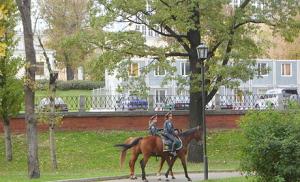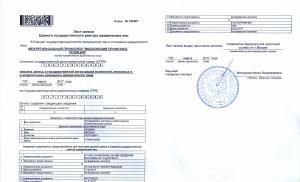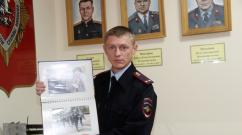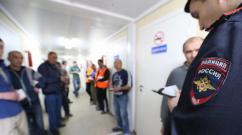Birds of our forests. Which bird breeds birds in winter? Crossbill coloring book for kids
A small mobile bird with a cross-curved beak is often called a northern parrot, but in fact it is a crossbill - a bright representative of the passerine order and the finch family. The most common species is the common crossbill, also known as the spruce crossbill.
Spruce crossbill.  Spruce crossbill.
Spruce crossbill. 
 Klest female.
Klest female.  Klest male.
Klest male.
The unusually shaped beak and bright plumage of the bird gave rise to an interesting legend: it is believed that a small bird flew to the crucified Christ on the cross and struggled to pull the nails out of his body. But the fearless bird did not have enough strength, and she disfigured her beak and stained herself with the blood of Jesus. Since then, the crossbill has been called the "Christ bird" and not only because of its beak and bright color. Crossbills are one of the few birds capable of producing offspring at Christmas, and their bodies remain incorruptible after death.
What does a cross look like
Klest - a bird - is small, slightly larger than a sparrow. The average body length of adult specimens reaches 17 cm, and the weight ranges from 43 to 57 g.
Interestingly, the color of the crossbill's plumage changes greatly as it grows older. The first months of life, the chicks are completely different from their parents, their feathers are gray in small streaks. First-year males can be recognized by their orange-yellow plumage. Adult crossbill - the male is distinguished by a red or reddish-crimson outfit. The color of females resembles the plumage of budgerigars: their feathers are greenish-gray, only the very tips are colored yellowish-green.
Individuals of both sexes have a rather large head, a short tail with a deep cut and strong, tenacious paws that hold the bird upside down on a spruce cone.
Compared with the closest relative, the pine crossbill, the beak of the common crossbill is not particularly powerful, longer, not bent so much, and the sharp tips do not cross so pronounced. This feature is due to the fact that it is easier to extract seeds from spruce cones than from pine cones .
 Crossbills during their feeding do not so much eat seeds as they scatter them around. In the photo, just such a moment - a seed flies from above from a cone chosen by a crossbill.
Crossbills during their feeding do not so much eat seeds as they scatter them around. In the photo, just such a moment - a seed flies from above from a cone chosen by a crossbill.  A pair of spruce crossbills against the background of fighting males.
A pair of spruce crossbills against the background of fighting males.  Spruce cross female.
Spruce cross female.  The crossbill is a spruce male gutting cones on a larch.
The crossbill is a spruce male gutting cones on a larch.  Spruce crossbill breakfast.
Spruce crossbill breakfast.  Spruce crossbill.
Spruce crossbill. Where does the crossbill live
The range of the common crossbill passes through the territory of Eurasia, North and Central America, North-West Africa.
Habitual crossbill biotopes are coniferous and mixed forests with a predominance of spruce. In pine forests and deciduous forests, these birds rarely settle, and in cedar forests they are not found at all. The way of life of the crossbill is closely connected with the harvest of coniferous trees, therefore, in lean years, birds roam and gather en masse in areas where a lot of spruce cones have grown, and migrations occur at any time of the year.
The crossbills practically do not leave the trees, quickly flying from place to place, so getting a photo of the crossbill is a great success. It is enough for an experienced ornithologist to hear the characteristic “kep-kep-kep” in order to determine a flock of crossbills calling to each other in flight.
If coniferous seeds are not enough, sunflower seeds, various weeds, and occasionally insects appear in the diet of birds. Feeding mainly on the resinous seeds of spruces, crossbills "embalm" themselves during life, so bird carcasses are mummified and do not decompose for a long time. For the same reason, the crossbill has almost no natural enemies; the meat of these birds turns out to be too bitter for predators.
 Spruce crossbill male on larch.
Spruce crossbill male on larch.  Spruce crossbill.
Spruce crossbill.  Spruce crossbill.
Spruce crossbill.  A crossbill male fumbles in the snow.
A crossbill male fumbles in the snow.  Male Spruce Crossbills in Deschutes National Forest, Oregon (USA).
Male Spruce Crossbills in Deschutes National Forest, Oregon (USA).  Spruce crossbill.
Spruce crossbill.  Spruce crossbill.
Spruce crossbill.  Spruce crossbill.
Spruce crossbill. Reproduction features
An amazing feature of the crossbill is the ability to bring offspring at sub-zero temperatures, when there is still snow around. The breeding season also depends on the yield of conifers, it can occur in any season, but is more often observed in March.
The current males sit on the tops of the trees and call the females, overflowing with trills, turning into whistles, creaks and chirps.
The female is engaged in the construction of the nest, choosing a secluded place among the dense spruce paws. The nest is twisted from thin twigs, and the inside is lined with feathers, lichens and animal hair. The clutch consists of 3 - 5 bluish eggs with a brown speck. Incubation lasts 14 days, after which the parents feed the offspring for about 2 months, until the beak of the chicks takes on a characteristic cruciform shape.
The crossbill is a singing bird and unpretentious in content, so some lovers get a "northern parrot" as a pet. Under good conditions, the vocal repertoire of birds expands markedly, and life expectancy reaches 10 years.
There is another type of crossbill - pine crossbill. Its color is almost identical to the color of the spruce crossbill, and the main difference is the larger beak. In addition, this is the most krypny type of crossbills.




 A female pine crossbill in a larch crown.
A female pine crossbill in a larch crown. Educational material about the birds of our forests for younger students
"Birds of our forests" - stories around the world (Grades 1-4)
Noskova Natalya YurievnaPosition and place of work: primary school teacher MBOU - Verkh-Tulinskaya secondary school No. 14 Novosibirsk region
Description: I bring to your attention stories for children about forest birds. This material will help teachers and educators diversify classes using stories. Children will be interested not only in stories, but also in illustrations with these birds. If the child knows about the bird, then listen to his story, and then supplement the child's knowledge with the proposed stories. A reading child can read these stories to his classmates. For teachers, this is a cumulative material on the outside world.
Purpose: material to help the primary school teacher and educator.
Target: familiarization of children with the birds of our forests.
Tasks:- to expand children's knowledge about the birds of the forest;
- to promote the development of thinking, mindfulness, memory;
- to cultivate interest and respect for nature.
forest birds
CrossbillThe crossbill is a bird, slightly larger than a sparrow, its body length is up to 17 cm. Dense physique. The name of this bird comes from the old Russian word “klestit”, which means “squeeze, squeeze, squeeze” (the word “ticks” also came from the word “klest”). As if strongly compressed. Thanks to this beak, the crossbill very deftly bends the scales on the cones and takes out delicious seeds. It's funny to watch how the crossbill peels off the cone: tenaciously grabbing with its paws, it, like an acrobat, hangs on a branch upside down. cones and drags it onto a branch.Closing the cone tightly with its paws, the bird puts its crooked beak under the scale and spreads its jaws.The scale sticks out, and the crossbill extracts the seed by the “wing” with its tongue. Seeds of coniferous plants form the basis of the crossbill's nutrition.

Three species live in Russian forests: spruce crossbill (eats spruce seeds), pine crossbill (eats pine seeds), white-winged crossbill (eats larch seeds).

The coloration of males is a bright red-cherry color, while the females are yellowish-gray. Crossbills live in flocks, often in taiga and mountain coniferous forests. With the advent of heat, when the seeds fall out of the cones and there is little food, flocks of crossbills roam the forest areas of the country, very far from their nesting sites. They stay on coniferous trees in flocks, often hanging from cones, plucking and dropping them. During the flight, they constantly call to each other. The voice of the crossbill is a sonorous “kle-kle”. The song is a twitter with a loud whistle.

Crossbills can hatch chicks at any time of the year, depending on the yield of cones. In fruitful years for cones, crossbills nest from February. The nest is made in the trees. On a high Christmas tree, a pair of crossbills builds a warm nest, sheltered from bad weather by dense spruce branches. At this time, the seeds of spruce and pine ripen, the cones open, filling the forest with seeds. Crossbill parents clean them, soak them in the goiter and feed the chicks.

Raven is a large omnivorous bird. Body length 60-65 cm, weight up to 1.5 kg. The color of the raven is black with a blue, greenish, purple tint. The legs and beak are black. Excellent vision. In search of prey, it can fly around a fairly large area. The sounds that crows make are sharp, loud cries of "kar-kar" or a restrained "kruk".

This is a whistling raven.
Ravens are prone to onomatopoeia and can learn to mimic dog barks and other sounds.

Ravens live in forests, steppes, mountains, they can live near rocks and coastal cliffs. They feed on small rodents, eggs, fish, but they can also eat plant foods. Raven benefits by performing a sanitary role.

Crows mostly live in pairs. During the nesting period, the male and female jointly build a nest. Place it in the dense crowns of tall trees. Inside it is lined with wool and dry grass. The female incubates the eggs for 20 days. There are usually 3-7 eggs in the nest. At this time, the male guards the female, brings her food. After leaving the nest, the chicks stay with their parents for some time, and then gradually get used to an independent life.

In the mythology of European peoples, the raven was considered a companion of wizards, a symbol of wisdom. It was believed that this is a prophetic bird that can predict the future.
Ravens are the most intelligent birds, they can even get food using improvised "tools" and easily learn from each other. Ravens are easily tamed, and birds that are captive in childhood quickly learn to imitate human speech.

The oriole is a small song-singing migratory bird, a relative of the sparrow. The body length is about 25 cm. The plumage color of the male is golden yellow. The wings and tail are black, and there is also a black stripe from the beak to the eye. On the sides of the black tail are yellow spots, the beak is red. The female has a greenish coloration, with a spotted pattern on the underside of the body.
Distributed in Europe and Asia in deciduous and mixed forests. Feeds on insects and their larvae, caterpillars, berries.

Male and female build hanging nests together, placing them on thin branches of deciduous trees. Parents incubate eggs in turn for about 15 days.

Chicks are fed and trained by both parents. During nesting, male orioles are pugnacious and quarrelsome, so these birds build nests at a considerable distance from each other.
The song of the oriole is long and complex, the beautiful whistle resembles the sound of a flute: “fu-tiu-liu”, and the loud cry is the meow of an angry cat. The oriole is a rather shy bird, it does not adapt well to captivity.

Oriole destroys a huge number of pests of the forest and gardens. At the end of August, the orioles begin to fly to Africa for the winter and return only in the spring - in the second half of May.
In ancient times, there was a superstition that the oriole screams like a cat - unfortunately, this bird was feared. But in fact, most often cries similar to “vzh-ya-ya-y” are emitted by the oriole before the weather worsens.

The kingfisher is a small forest with dark spots. The throat, sides of the neck are white, the belly is reddish. The beak is long, straight, and the legs, wings and tail are relatively short.
The name of this bird appeared a long time ago, when it was believed that the chicks of the kingfisher appeared in winter, far in the south. This opinion arose because kingfisher nests are very difficult to detect. In the people, the kingfisher is also called the "fisherman".

Kingfishers are distributed throughout the globe. They live along the banks of rivers and lakes, there are also forest and semi-desert species. They prefer places with some kind of vegetation - trees and shrubs.

They feed on small fish, tadpoles, and aquatic insects. Sitting motionless on some branch, the kingfisher looks out for prey, dives after it, grabs it, emerges, takes off and eats it.

Kingfishers are able to sharply slow down in the air when flying, hover over water, dive into the water for prey. They have very good eyesight: they easily and accurately determine the distance to their prey. In winter they like to swim in the snow. Kingfishers emit a sharp, loud cry: "tee-ee-ee-p ... tee-ee-ee-p."
Kingfishers nest in separate pairs in coastal cliffs. For the nest, the male and female dig a mink, which begins with a tunnel and ends with a nesting chamber. There is no bedding in the nest. The female incubates the eggs for about 20 days. Hatched chicks are fed by both parents, first they bring small fish, then the size of the fish increases. As soon as young kingfishers learn to fly, they immediately leave their parents.

Many nations have legends and traditions about kingfishers. For example, it was believed that this bird made fire for people and scorched its abdomen, so it is bright red.

The owl is a nocturnal bird of prey. The size of the body of owls is different: from 40 to 180 cm, weighs from 50 g to 3.5 kg. The eyes are large, motionless, but the neck is very mobile, owls can turn their heads 270 degrees. The beak is strong, with a sharp curved hook at the end. The wings are wide, the claws are long and sharp. The tail is usually short. The plumage color is mostly gray and brown. Most often, females are larger than males. Owls fly silently.

During the day, owls usually lead a motionless lifestyle, so many believe that they do not see anything during the day and sleep. But it's not. The owl sees the same day and night, although the color is weakly distinguished. Her eyesight has another drawback - farsighted owls. An owl sees almost nothing next to itself. But her hearing is very sensitive.
In spring and summer, owls often call at night. Their voices are monotonous, like jerky (“uh-huh”) or drawn-out (“I sleep-yu-yu-yu”) groans.
Owls are widely distributed, they are not found only in Antarctica. They can live both in forests, and in gardens, and in parks. Sometimes they settled in old estates, estates, castles, terrifying the inhabitants of these places with their cry. The diet of owls is varied, large owls hunt for rodents, small ones feed on insects, some feed on fish.
How to draw a crossbill. This article is from the How to Draw Forest Birds series.
We are closest to the spruce crossbill and the pine crossbill. These are outwardly very similar birds, the difference is only in nutrition - spruce or pine seeds. And in accordance with this, the spruce has a slightly weaker beak, and the pine, which splits very strong nuts, has a thicker and more powerful beak.
Draw a crossbill - lesson 1
The crossbill belongs to the order of passeriformes - the family of finches. And thus, in appearance, he somewhat resembles his relatives - sparrows and bullfinches, that is, this bird is not large and of very ordinary proportions.
Teardrop-shaped body:

The wings are folded behind the back. The head is large with a high forehead and wide-spaced small eyes:

The most characteristic feature of crossbills is their beak - the mandible and mandible are crossed like X and are bent:

The paws of the crossbill are very tenacious; it can hang upside down, pecking at its prey (coniferous cone).

The tail is short with a rather deep neckline:

Well, we drew a spruce crossbill. The drawing is good, realistic can be used as a coloring book. But here I must say that the colors of these birds are very diverse and bizarre. Wikipedia says: "Males are red or red-crimson, the underbelly is grayish-white. Females are greenish-gray with yellow-green edges of feathers. Young birds are gray with streaks, first-year males are orange-yellow. Wings and tail are brown."
So here it is.
Let's draw a crossbill - lesson 2

Draw the body:

The neck is not hostile, the head is large with a large sharp beak:

Crossbill: children about nature. Which bird breeds chicks in winter? How amazing is this bird? Riddles, poems, stories, fairy tales, presentation about the crossbill and other forest dwellers for children. Cognitive fairy tale in pictures "Klest and woodpecker".
Today is a new page of our children's encyclopedia about wintering birds on the site "Native Path". She will introduce us to an amazing bird - the crossbill.
Which bird breeds birds in winter?
A story for children about the crossbill in pictures

Klesta always easy to recognize by its beak. Crossbills have a beak that looks like a cross. Try to draw a cross with a pencil. Now lay out a cross from two sticks. Does it look like a crossbill's beak? Have you seen such a beak-cross in other birds - sparrows, geese, ducks, chickens, pigeons? Not? That's right, you haven't seen it and you won't see it!!! Only crossbills have such a beak! They need it to get their own food - to get seeds from cones. You can’t get seeds from a cone with an ordinary straight beak! Therefore, if you see a bird with a cross-beak in a forest or park in winter, then know that this is a crossbill. You will never confuse him with other birds!

But the crossbill is famous not only for its beak-cross!
The crossbill is the most amazing bird! And the hottest! No frost is not afraid! And the chicks are brought out in a fierce winter during blizzards, snowstorms and severe frosts. And so the crossbills make a very warm and durable nest. And always their nest is very high on a pine or spruce, so that no one can get the chicks.
Crossbills build their winter house for chicks - their nest from dry spruce twigs, moss and lichens, soft roots. And to make it warmer, they line the inside with wool and feathers. Thick walls should be at this nest so that the kids do not freeze in it. The nest is built by the female - the mother of future chicks. And the male - papa-klest helps her. A warm, durable home is obtained from crossbills! Neither frost nor blizzard are terrible in such a house!
The frost on the street is such that people do not even walk in the parks, they hurry home as soon as possible. And the mother bird at this time sits on the nest, does not fly away from it anywhere. In the nest she has 3-4 small eggs, from which soon her little children - crossbills will hatch. For two weeks, the mother of the future sits on snow-covered branches. She can’t fly away - she needs to hatch chicks!
But how does the mother eat at this time if she cannot fly away from the nest? Who is feeding her at this time?(give the baby time to think and try to find the answer to the question) Of course, dad helps mom at this time - a crossbill that brings her food and takes care of her.
When the crossbills are born, the mother also does not leave them for a minute - she sits on the crossbills and warms them with her body.
Why do crossbilly chicks appear in winter? And because the crosses need special food! Which? Of course, special food - children's - the one that is given to children so that they grow well. And what kind of food is so very useful? (Let the baby try to name the useful foods that he knows and try to guess which ones the little chicks might need):
“What do you eat in the morning? Porridge. And what kind of porridge? (Buckwheat, oatmeal, millet, semolina - remember with your baby). And the crossbreeds also need porridge, but another - bird - spruce porridge !!! And there is a lot of such porridge only in winter, because it turns out from ... cones! Do you know such porridge? Not? Here, listen to what kind of porridge this is and how little crossbreeds grow.

N. Sladkov. Spruce porridge
Everyone's birthday is a joy. And the slanderers are in trouble. Well, what a joy to hatch in winter? Frost, and you're naked. One back of the head is covered with down.
All birds have parents as parents; children are taken out in the summer when it is warm and satisfying. Laws are not written for crossbills alone. Managed to sit out the slander in the winter, and even the twenty-ninth of February! What kind of birthday is it that happens once every four years? Right at least cry: no greenery, no caterpillars; snow, cold...
And parents though that!
There is a crossbill dad - he sits on his Christmas tree and sings songs. And at the very steam from the beak, as if smoking a pipe!
This is how I think about the slander.
I only see that the bastards themselves do not grieve!
The bastards eat porridge. Good porridge from spruce seeds! Porridge will be full - and sleep. From below, the nest is like a downy duvet, from above, mother is like a feather blanket. And from the inside, the porridge warms. The fir-tree is crossed, cradles, the wind purrs songs to them.
A few days have passed - the crossbills have grown. No throats were cold, no noses were frostbitten. Yes, they are so thick that it is crowded in the nest. And restless: they almost fall out of the nest.<
This is probably all from my mother's worries and from spruce porridge.
<А ещё от яркого солнышка и морозного ветра.
No, a birthday is always a happy day.
Even if it's winter and frost. Even the twenty-ninth of February.
Does not matter!<
You probably thought that since crossbills are born in such a severe frost, they are dressed in a very warm coat like bunnies or squirrels in winter? But no! Their fluff is the same as that of the chicks of other birds that hatch in the spring. And only mom warms them! Without a mother, the bastards will be lost! Mom warms the nest with her body so much that it is warmer in it than in our house! Blimey! You don't even need batteries or a stove!
Then the crossbreeds grow up, and the mother briefly begins to fly out of the nest. How cold then the kids! They hide their heads under their tummy to keep warm. And when mom comes back, they quickly warm up under her. Feeds mom and kids dad-klest. He brings spruce seeds, gives them to his mother. And the mother feeds her babies with them - they slander.
Parents have to feed their babies for a long time, because they are still small and they themselves do not know how to get food from cones. Indeed, in adult crossbills, the beak is crossed, and in chicks, the beak is straight. You can’t get a single seed from a cone with a straight beak! But as the kids grow up, they begin to learn how to extract seeds from cones, their beak will also bend and become like a cross. Then they will begin to get their own food, with their beak-cross of the scales of the cone to push apart and get the seeds.
Crossbills are very friendly birds. They like to fly in flocks and always build nests where there are many cones with seeds. But as soon as the couple wants to bring out the chicks, they fly away from the flock, make a nest and live in it. And as the crossbreeds grow up, the family with the crossbreeds returns to the common flock. A flock is easier to feed and survive in the forest.

Crossbills have another name. They are called very funny - "northern parrots" Guessed why? How are they similar to parrots? Yes, they are bright as parrots, they also have wings, legs, a head, a tail, they also know how to fly. And crossbills, like parrots, can climb branches, even hang upside down! Take a look at the picture. They are like real dexterous gymnasts! Hang on a branch upside down and eat the seeds!
Crossbills to the end of the seeds from the cones never peck out. A little bit of seeds will be pecked, and the rest will be left in the cone. And after eating, they drop the cone on the ground. And therefore, we can say that crossbills are very useful birds for the forest. They plant forests like foresters. How can they plant a forest if they don't even have hands, only wings? (Give the child the opportunity to reflect on the answer to this question, prompt him with questions: “What does a spruce or pine grow from? From a cone! Where should the cone be so that the seeds from it fall into the ground and then become small Christmas trees or pines? How can a crossbill help a tree and its children - seeds? ". Tell us that from the cones thrown by crossbills on the ground, then small trees grow. Therefore, about crossbills, we can say that they plant a forest)
Speech exercise "What are crossbills: Think of a word"
Surely you have seen different dogs. There are shepherd dogs. There are spaniels, there are poodles, bulldogs, collies and many other different dogs. And the crosses are also different. We have three types of crossbills in Russia. Try to guess by the name why they are called that.

- Some crossbills are called like this: Klest - pine" (stress on the third syllable). Guessed why? What does he eat? (Pine seeds).
- There are other crosses. They feed on spruce seeds. Guess what they're called? I'll tell you: “Pine crossbill eats pine seeds. And the crossbill eats the seeds .... ?( elo-vik)»
- And the third cross is called " white-winged". Have you already guessed why? That's right, he has two white stripes on his wings. He eats larch seeds. And that's why it's called guess what? (Listen to all the child’s suggestions, let him come up with his own words, encourage word creation and any invented versions of the word. And then say: “Because he eats larch seeds, they began to call him larch. Beautiful word - "larch", right? Do you like it?")
And now let's play a fairy tale finger theater for children.
As forty crossbills judged:
fairy tale for children 5-6 years old
After reading this story, discuss it with your child:
- Why did the white-sided magpie decide to judge crossbills? What forest orders violated crossbills?
- What birds flew to the call of the magpie? Did they agree with the magpie? Why?
- What interesting things did you learn about the life of crossbills? What else do you want to know? (The ability to ask questions is a very important skill that needs to be developed already at preschool age. Therefore, encourage any questions your baby has and find the answer with him in a book, encyclopedia or on the Internet)
- What do the words about the chicks "they will stand on the wing" mean?

This time the girl went for a walk in the winter forest. Silence in the forest. The forest sleeps under a thick snow blanket. The birch trees in white hats bowed their heads, the Christmas trees bent their paws under the weight of snow. Suddenly - noise, flapping of wings, chatter. This white-sided magpie plopped down on a branch of a Christmas tree, shook the snow off it, crackled, chirped. A crossbill peeked out from under a heavy spruce paw:
- Listen, do not make noise, do not crack! Don't scare my chicks!
- What? Chicks? In the winter forest? You, crossbill, violate forest orders. The chicks are supposed to hatch in the spring. Hey, birds, fly all here! Klest will be judged for violating forest orders. The red-breasted handsome bullfinch flew first to the call of the magpie and sat on a rowan branch.
- What's that noise? What the hell is there to judge? - he asked.
- Why, the magpie says that I violate the forest orders, I bring out the chicks in the winter.
- Aren't you afraid of the cold?
- Not. We make a very thick nest from small twigs, we insulate it with wool, feathers, and hide it among spruce branches. This is where the crossbill lays its eggs.
- What if even in such a warm nest, the eggs will freeze? he asked.
- Not. Klestiha sits on them for half a month, warms with her warmth.
- How does she eat? - asked the titmouse, which had long been swaying on a birch branch and listening to the conversation.
“I bring her seeds from fir cones, buds of fir trees and birches,” said the crossbill.
- Well done crossbills! They are not afraid of frost, - a woodpecker joined in the conversation, clinging to the trunk of a spruce. - I've been watching them for a long time. Friendly birds! And they have the right food. They love spruce seeds as much as I do.
An aunt owl crawled out of a hollow in an oak tree and said:
- Although I can’t see anything during the day, I hear everything well. Well done, crosses! By spring, their crosses will stand on the wing. Do you know how many trees will grow from the seeds they dropped?
- You are not right, forty, - said the bullfinch.
- You're cracking to no avail, - the tit supported him.
- There is nothing to judge the crossbill for, - the woodpecker put an end to it.
Here all the birds rustled, roared. The magpie waved its wings at them and flew away. And the girl who watched the whole story smiled, was happy for the crossbill and went home. (Author - N.V. Nishcheva. Fairy tale from the book "Developing Tales" - Childhood-Press, 2002)
Crossbill cartoon for kids
In this cartoon, kids will get acquainted with forest dwellers and find out who winters like. After watching the cartoon, ask the child: “Why couldn’t the thrush (caterpillar, bear, crossbill) come to the hare for the New Year? And who came to the tree? (Consider the last shots - bullfinches, fox cub, deer, wild boar, squirrel, hares). Ask which of the forest dwellers your kid would invite to the New Year's holiday (who could come to it). Who would you like to invite to your summer party?
http://youtu.be/wOvOuLQ4VAc
Who are the crossbills friends with?
Remember what trees the crossbills are "friends" with? (With spruce, pine, larch).
Friends always help each other. How do crossbills and spruces and pines help each other? How does spruce and pine help crossbills? (The Christmas tree and pine give them food - the seeds of cones). But how do crossbills help these trees? (Remind the child that the crossbills eat only part of the seeds, the rest of the seeds remain in the cone. The cone with the seeds falls to the ground, and in the spring the seeds germinate. It turns out that the crossbills, like foresters, plant a forest and help these trees)
What animals are crossbills "friends" with? Who eats the seeds from the cones that the crossbills have dropped on the snow? (Squirrels, mice) Crossbills are real friends with mice! The mouse cannot pick a cone from a tree. And the crossbills drop cones with seeds on the ground, so the mice feed on these seeds and say “Thank you” to the crossbills for this. We can say that the food itself comes to them, or rather, it flies from the tree!
And who else eats cone seeds in the forest? Squirrels. They also eat up the seeds of the cones behind the crossbills. Only squirrels are not friendly with crossbills. They don't even say "thank you" for the food. Do you want to know why?
Nikolay Sladkov. How crossbills made squirrels jump in the snow
Squirrels do not really like to jump on the ground. If you leave a trace, a hunter with a dog will find you! Trees are much safer. From the trunk - to the knot, from the knot - to the branch. From birch to pine, from pine to Christmas tree. There the kidneys will gnaw, there are bumps. That's how they live.
A hunter with a dog walks through the forest, looks under his feet. There are no squirrel tracks in the snow! And on spruce paws you will not see traces! On spruce paws there are only cones and even crossbills.
These are beautiful crosses! Males are purple, females are yellow-green. And the great masters peel the cones! The crossbill will tear off the cone with its beak, press it with its paw and let's bend the scales with a crooked nose, peel the seeds. It will bend the scale, bend the second and throw the bump. There are a lot of bumps, why feel sorry for them! Crossbills will fly away - a whole pile of cones remains under the tree. Hunters call such cones crossbow carrion.
Time goes by. Crossbills pluck everything and pluck the cones from the Christmas trees. There are very few cones on the fir trees in the forest. Squirrels are hungry. Whether you like it or not, you have to go down to the ground and walk downstairs, dig out crossbill carrion from under the snow.
A squirrel walks below - leaves a trail. Followed by a dog. The hunter is after the dog.
Thanks to the crossbills, - says the hunter, - they lowered the squirrel to the bottom!
By spring, the last seeds will fall out of all the cones on the fir trees. Squirrels now have only one salvation - carrion. In the carrion, all the seeds are intact. Throughout the hungry spring, squirrels pick up and peel carrion. Now they would like to say thanks to the crossbills, but the squirrels do not say. They cannot forget how crossbills made them jump in the snow in winter!
- Why don’t squirrels say “thank you” to crossbills? > What can’t they forget?
- Why don't squirrels like to come down from trees in winter? What makes them descend from the trees into the snow in winter?
- What is a "dump"?
Stories about crossbills for children
Cognitive fairy tale in pictures "Klest and woodpecker" (N. Sladkov) for children 6-7 years old
You can download the presentation for this fairy tale for free in our Vkontakte group “Child Development from Birth to School” (see the “Documents” group section in the right column). It contains all the pictures of this article in good resolution and high quality for more convenient viewing with children on a home computer monitor or screen.
I look, Woodpecker, at your nose and compare it with mine,” said Klest. Yours is straight, like a chisel, and mine is like two crooked screwdrivers. And yet my curve will be better than your straight line.












The story about crossbills by V. Bianchi "To whom the laws are not written" (for younger students)
Now all the forest dwellers are moaning from the cruel winter. Forest law says: in winter, escape from the cold and hunger as best you can, but forget about the chicks. Take out the chicks in the summer, when it is warm and there is plenty of food.
Well, and to whom the forest is full of food even in winter, this law is not written for him.
Our correspondents found a nest of a small bird on a high Christmas tree. The branch on which the nest is placed is completely covered with snow, and the testicles lie in the nest.Our correspondents came the next day - it was just a bitter cold, everyone's noses are red - they look, and the chicks have already hatched in the nest, naked lie in the snow, still blind.
What a miracle And there is no miracle. This couple of spruce crossbills built a nest and brought out chicks.
Such a crossbill bird that it is not afraid of cold or hunger of winter.All year round you can see flocks of these birds in the forest. Calling merrily, they fly from tree to tree, from forest to forest. All year round they lead a nomadic life: today here, tomorrow there.
In the spring, all songbirds break into pairs, choose a site for themselves and live on it until they hatch their chicks.
And the crossbills even at this time fly in flocks through all the forests, not stopping anywhere for a long time.In their noisy flying flocks all year round you can see together with old and young birds. As if their chicks will be born in the air, on the fly.
In Leningrad, crossbills are also called "parrots". This name was given to them for their motley and bright, like a parrot, outfit and for the fact that they climb and spin on perches, also like parrots.
Feathers of male crossbills are orange in different shades; in females and young - green and yellow.
The paws of crossbills are tenacious, the beak is grasping. Crossbills like to hang upside down, holding on to the upper branch with their paws, and grabbing the lower one with their beak.It seems quite a miracle that the body of the crossbill does not rot for a very long time after death. The corpse of an old crossbilly can lie for twenty years - and not a single feather will fall from it, and there will be no smell. Like a mummy.
But the crossbill has a nose that is most interesting. No other bird has such a nose.
The nose at the crossbill is crossed: the upper half is bent down, the lower half is up.In the crossbill's nose is all the power and the solution to all miracles.
Crossbills will be born with straight noses, like all birds. But as soon as the chick grows up, he begins to get seeds from spruce and pine cones with his nose. At the same time, his still tender nose is bent crosswise, and it remains so for life. This is good for Klest: with a cross nose it is much more convenient to peel the seeds from the cones.
This is where everything becomes clear.
Why crossbills roam the forests all their lives?
Yes, because they are looking for where the best crop of cones is. This year we have bumps in the Leningrad region. We have crosses. Next year, somewhere in the north, a cone harvest - crossbills there.Why do crossbills sing songs in winter and take chicks out among the snow?
But why shouldn't they sing and raise chicks, since there is plenty of food around? The nest is warm - there is down, and a feather, and soft fur, and the female, as soon as she lays the first testicle, does not leave the nest. The male brings food to her.The female sits, warms the eggs, and the chicks hatch, - she feeds them with spruce and pine seeds softened in the goiter. There are cones on the trees all year round.
A couple will come together, want to live in their own house, take out small children, fly away from the flock, it doesn’t matter whether it is in winter, in spring, in autumn (in every month nests of crossbills were found). Build a nest - live. The chicks will grow up - the whole family will again stick to the flock.
Poems about Crossbills

Crossbills
In winter, when the birds flew south,
Leaving his usual place,
Snow and blizzards swirled in the forest,
Animals crawled into dens and burrows.As soon as the crossbills on the branches have fun,
Spruce cones deftly peel.
They are more than full of seeds -
Any frost will win then.Happy songs they sing
And the chicks are taken out into the fierce cold.
Their bright feathers shine in the sun.
Well, who will understand these bold crossbills?And hang upside down on the branches,
Holding on to a branch with a strong beak.
Suddenly, a flock from spreading branches take off,
In the shimmering sky, circling for a long time.When everything in the forest freezes until spring,
The forest paths are sadly empty,
Under the cold snow, the earth falls asleep.
But life triumphs - there are crossbills on the branches. (Tatiana Kersten)
Crossbills chicks
The snow is spinning, falling
rushes like a blizzard,
rejoicing in whiteness
spreads softly
and sparkling snowflakes
sprinkles the earth.
Snow with hard hands
everything is in a hurry to hide.The chicks would not be cold,
yellow Klesti.
They click like tweezers
cross beaks.
Under the fir tree
the chicks are sitting.
Mom and dad for kids
bumps are teasing. (Irina Baty)
Riddles about the crossbill
He is not afraid of blizzards,
Nests build in winter on spruce,
His cry is abrupt, simple,
Crooked red…
(P. Smolin)
The beak of that bird is not simple
Strong, bent and overlapped,
The growth of that bird is small,
And the name of that bird is ... (crossbill).
(Vladimir Talyzin)
So our meeting with an amazing bird called crossbill. I hope it was interesting for you and your children. See you in the rubric!
You can download a presentation with pictures of this article in high resolution and high quality in our Vkontakte group “Child Development from Birth to School” (see the “Documents” section of the group under community videos). The presentation is editable.
To make it more convenient to deal with children based on the materials of this article, below I give a presentation with pictures of the article. For full screen viewing, click the icon in the lower right corner of the screen.
Presentation "Klest"
You can present a presentation for children with pictures from this article in high resolution and quality either in our Vkontakte group “Child Development from Birth to School” (in the “Documents” group section).
You will find more interesting materials about wintering birds for games, activities, projects with children in the articles:
Informative stories, videos for kids, speech and logic tasks about birds in winter, riddles, poems, finger gymnastics, games.













